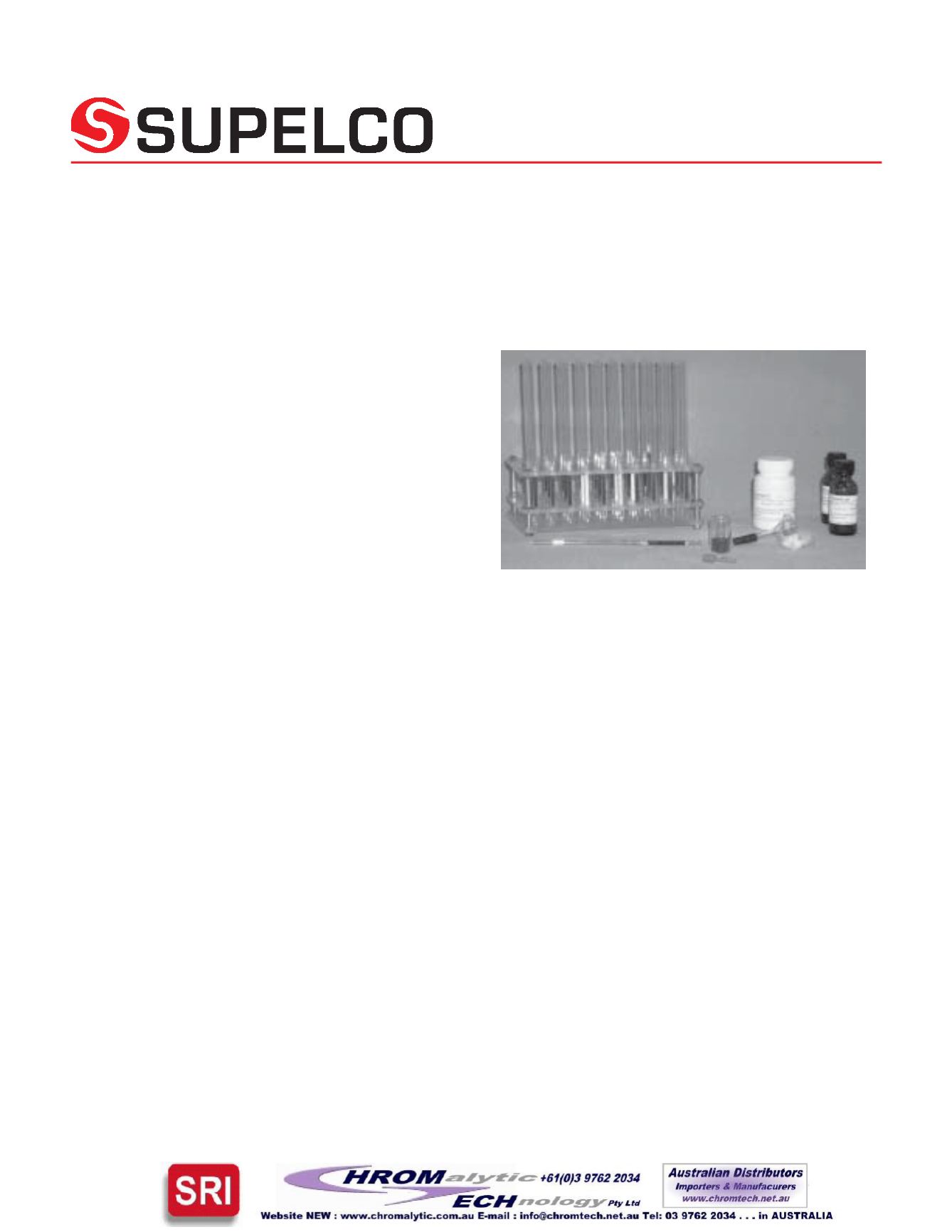
SupelcoPark
•
595NorthHarrisonRoad
Bellefonte, PA16823-0048USA
Telephone800-247-6628
•
814-359-3441
Fax800-447-3044
•
814-359-3044
email:
sigma-aldrich.com/supelco
Technical Report
We a r e c ommi t t e d t o t h e s u c c e s s o f ou r Cu s t ome r s , Emp l o y e e s and Sh a r e h o l d e r s
t h r ou g h l e a d e r s h i p i n
L i f e Sc i enc e
,
Hi gh Te chno l o g y
and
Se r v i c e
.
ATool for Selecting anAdsorbent for
Thermal DesorptionApplications
Research conducted by JamieBrown, R&D, Co-author BobShirey, R&D
There are varieties of adsorbents used in the field of
thermal desorption. Often choosing the right adsor-
bent canbe difficult. The goal in selecting the proper
adsorbent is tochooseone thatcanretainaspecificor
groupofanalytes foraspecifiedsamplevolume.How-
ever, justas important theadsorbentmustalsobeable
to release the analyte(s) during the desorption pro-
cess. This report sheds some light on choosing the
right adsorbent by demonstrating the relative differ-
ences between thosemost commonly used. Some of
theadsorbentsinvestigatedinthisresearchwereTenax
TA
®
, Carbotraps™, Carboxens™, Carbosieve™, char-
coals,andglassbeads.Thetestprobeforthisresearch
wasagasmixcontaining forty-threedifferentanalytes
whose physical properties ranged from 50 to 260 in
molecularweightand -30 to215°C inboilingpoint.The
analytes inthismixtureareasubsetoftheEPAHazard-
ous Pollutant list. EPA method TO-17 is the typical
method you use to sample these analytes. We intro-
duced thisgasmixture toeachof theadsorbentsusing
the flash vaporization technique and then challenged
eachwithvarioussamplingvolumes ranging from0.2
to 100 liters. We thermally desorbed each of the
adsorbents intoaGC/MSDsystem.
Tableof Contents
Introduction
Ourgoal inperforming this researchwas todevelopasimpleand
easy touse tool for thermal desorptionusers. This “tool” demon-
strates the relativedifferencebetween theadsorbentsbasedon
their capability to efficiently retain and release an analytewhen
challenged with various sample volumes. Several other condi-
tions such as sampling flow rate, storage conditions, and the
relativehumidityof thesampledair canall influence theabilityof
an adsorbent to retain an analyte during the sampling process.
This research covers only the sample volume aspect.
The challengeweposed toeachof theadsorbentswas to spike
a known quantity of a test mix onto the adsorbents. Then
challenge the adsorbent by subjecting it to a constant flow of
clean nitrogen until we obtained the desired volume. We then
thermally desorbed the adsorbents into a GC system to deter-
minewhat analytes remained (recovered)on theadsorbent after
itwesubjected it to thechallengevolume. Thiswas repeated for
six different volumes of nitrogen.
An analogy that depicts the challenge posed by this research is
that of packed column chromatography. For this, we pack the
adsorbent intoacoiledcolumn;weapplyacarriergas tocarry the
analytes from the injection port through the column to the
detectorat theoppositeend.Essentially thesameconceptsexist
herewhen samplingwitha thermal desorption tube. Theadsor-
bent ispacked intoanempty thermal desorption tube (verysmall
column).Thecarriergas for this researchwasnitrogen,but in the
realworld, itwouldbeair.TheAdsorbentTube Injectorservesas
the injection port to introduce the gasmix into the nitrogen gas
stream. The analytesmigrate through the adsorbent bedwhere
at some point in time, some of the analytes break-through
whereas,othersare retainedby theadsorbent. Insteadofhaving
adetector at theendof the tube toanalyzewhat broke-through,
this research looks at what analytes the adsorbent retained.
Thermal desorptionof the tube releases theanalytes in theGC/
MS system for detection.


